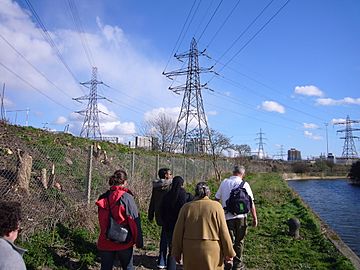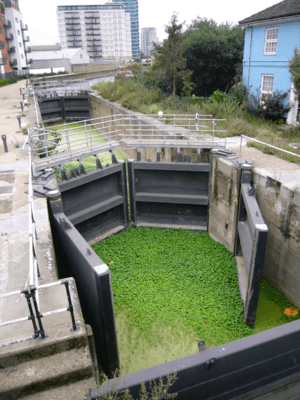City Mill River facts for kids

Walkers next to the City Mill River in 2007
|
|
| Waterway | Bow Back Rivers River Lee |
|---|---|
| County | Newham, Greater London |
| Maintained by | Canal & River Trust |
| Operation | hydraulic |
| Coordinates | 51°32′00″N 0°00′33″W / 51.533323°N 0.009146°W |
City Mill River is a cool part of the Bow Back Rivers in London, England. It used to power a mill called City Mill. This mill made chemicals a long time ago, in the late 1800s and early 1900s.
In the 1930s, the mill was taken down. Then, special gates called locks were built at both ends of the river. These locks stopped the river from being affected by the ocean's tides. City Mill Lock, which is at the south end, was fixed up and opened again in 2010.
Contents
Exploring City Mill River's Past
City Mill River starts where the old River Lea used to flow. It then moves south-east towards City Mill. Old maps from 1895 and 1923 show that the mill was used to make chemicals. The mill was built right over the river channel.
There was also a smaller stream that went around the mill. It joined the Waterworks River further down. By the late 1920s, many of the Bow Back Rivers were in bad shape. So, the Lee Conservancy Board and West Ham Corporation got money from the government. This money was part of a plan to help people find jobs.
River Improvements in the 1930s
Work began in 1931 and took four years to finish. The River Lee (Flood Relief) Act of 1930 made these improvements possible. The river's path mostly stayed the same. However, at the southern end, the old mill was removed. The river channel was then moved through the area where the mill used to be.
Part of the mill's old water area was filled in. The river then joined the Bow Back River. This river was also moved a bit north. The Waterworks River, which was east of the mill, was made wider. It was also moved a bit to the west.
How Locks Changed the River
A new lock was built to connect City Mill River and Waterworks River. This meant City Mill River was no longer affected by tides. City Mill Lock stopped the southern end from the tidal Waterworks River. Carpenter's Lock did the same at the northern end.
This allowed the river's water level to stay the same as Limehouse Cut. It became "semi-tidal" because high tides could still flow over the gates. This caused small changes in the water level during very high tides.
Understanding City Mill Lock
City Mill Lock connects the Bow Back River and City Mill River to the Waterworks River. It was built during the 1930s improvement project. Unlike Carpenter's Lock, which used special vertical gates, City Mill Lock has traditional "mitre gates." These gates meet in a V-shape.
How the Lock Gates Work
City Mill Lock has two sets of gates that point west. These allow boats to pass when the Waterworks River is lower. A third set of gates points east. These stop high tides from the Waterworks River from pushing the gates open. This prevents City Mill River from draining when the tide goes out.
The lock is about 20 feet (6.1 m) wide. It can handle boats up to 87 feet (27 m) long. The original gates lasted for nearly 70 years. But by 2000, they were considered unsafe. They were replaced with temporary barriers.
Restoring City Mill Lock
In 2005, the lock was partly fixed up. This was part of a deal with developers building nearby homes. Three new steel gates were made in Sheffield and installed. This cost about £200,000. Another £100,000 was spent on improving the area around the lock.
After this work, the lock was in good shape but not fully working. It needed balance beams and a system to open the gates. Money for this came from developing the area for the 2012 Summer Olympics. Another £200,000 was spent on the hydraulic systems. These systems use water pressure to open the gates.
This money also paid for sluices (water channels) and controls. Ladders and landing stages were added for boaters' safety. The work was finished in 2010. The lock officially opened on July 31st.
Dealing with Invasive Plants
During the restoration, workers had to clear a lot of plants. Especially common was water pennywort, Hydrocotyle ranunculoides. This plant is not native to the area. It grows very quickly and forms a thick mat on the water's surface.
This dense mat stops other plants from growing. It also makes it hard for animals and boats to move. Herbicides were used to remove this invasive plant.


